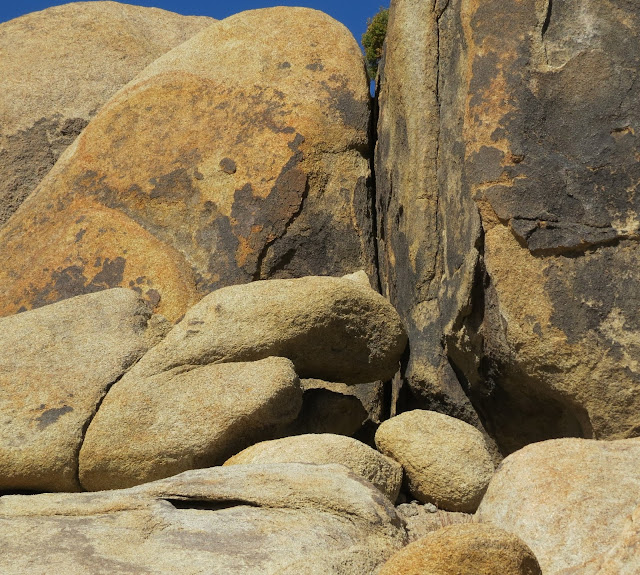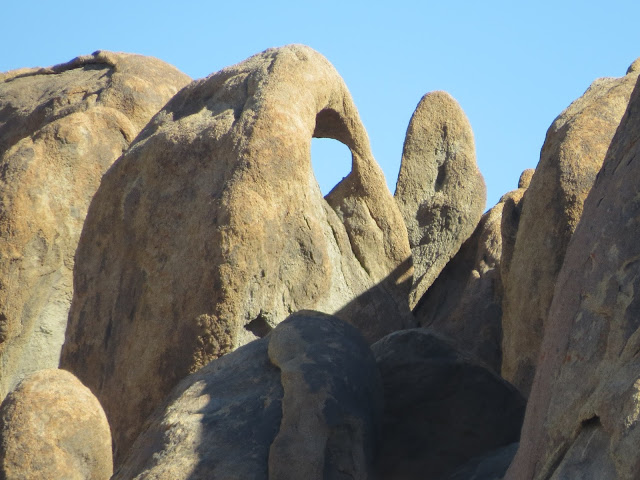This week we remember it's Saturday, and avoiding the Portal and the Alabama Hills keeps us from crowds on this hazy autumn day.
Years ago I visited the Mt Whitney Fish Hatchery north of Independence, CA, on my job with the union. I knew Bill would enjoy all the fish, and I remember it is a really beautiful location.
 |
| "Design a building to match the mountains, last forever, and be a monument for all time." MJ Connell, 1915 |
It is now a historic site, no longer a working hatchery. I feel bad that I didn't know the flood of 2008 wiped out not only the ponds, but Oak Creek that fed them.
I am happy to see the beautiful front pond is still here, as are the enormous Golden Trout for which the hatchery is famous. Bill is itching to grab a pole.
Volunteers with Friends of Mt. Whitney Fish Hatchery continue to maintain the hatchery grounds, a simple museum and interpretive center, as well as two indoor ponds, and a small egg collection and hatching operation. Because they are not a certified hatchery, the fish they raise cannot be released in any public body of water. Instead they stock their pond, and once a year kids younger than fishing license age are invited to come and fish all day - taking home what they catch.
 |
| Hatched to live their whole lives here |
We enjoy the exhibits and the movie, but it is the continued commitment by this little community that is really moving. The hatchery property was purchased in 1915 by citizens of Independence and given to the state of California. When budget cuts threatened closing the hatchery, the Friends stepped up and kept it going, and when the state deactivated the facility following the flood damage, they cleared the front pond, completed repairs, and reopened the hatchery as a historic site. They continue to work toward reactivation.
 |
| Planting fish with mules |
 |
| Wonderful exhibit of local reptiles |
 |
| Lighted photos tell the history of the hatchery |
 |
| Mining claims map - thousands in every mountain range |
Leaving the hatchery we drive west to find Oak Creek. In 2007 fire ravaged the mountains here, leaving the watershed bare and unprotected. The heavy rains of 2008 brought logs and rocks and tons of mud rushing downhill.
Oak Creek is only now beginning to carve a new path. The south fork rushes through concrete gates set up to direct the water through the devastated canyon. Walls of mud and rock cover miles of landscape with only a handful of trees in sight.
 |
| Gates on Oak Creek help in restoration efforts |
 |
| Beat up, but still standing strong. And trees. |
 |
| Large mud flows take the place of Oak Creek |
 |
| Over five feet high, full of rocks and logs |
From the road, the former route of the north fork is defined by a dark line down the hill, while a thin green new route runs a few miles north.
Eight years later the level of destruction still visible here is a sobering reminder of the terrible power of rushing water.
I want to see the extensive collection of Owens Valley Paiute and Shoshone baskets at the Eastern California Museum, also in Independence. While this sounds as appealing to Bill as oral surgery, he enjoys the local history exhibits with me.
 |
| Includes 25,000 photos covering over a 100 years of local history |
 |
| Much of the area's history is shaped by the water wars |
 |
| Los Angeles as the "good neighbor" |
 |
| A large exhibit about Clyde's mountaineering makes me want to read more about him |
 |
| Museum humor :-) |
An author is giving a presentation with slides in the corner of the Anna and OK Gallery, and the lights are turned off. I have to use my cell phone flashlight to see the collection. Definitely "different", and a good excuse for Bill to take Tessa outside.
 |
| The story-teller baskets are my favorites |
It is a large and beautiful compilation, including bead-work, arrowheads, and blankets. Even without proper lighting, I appreciate this opportunity.
 |
| 100-year-old beaded straps |
The small desert garden outside is suffering from the extended drought, but it is a pretty site, nicely maintained.
 |
| Mary DeDecker Native Plant Garden |
Again we've seen things on our list, as well as new surprises we never expected. It's why we love taking our time in our travels :-)
































































